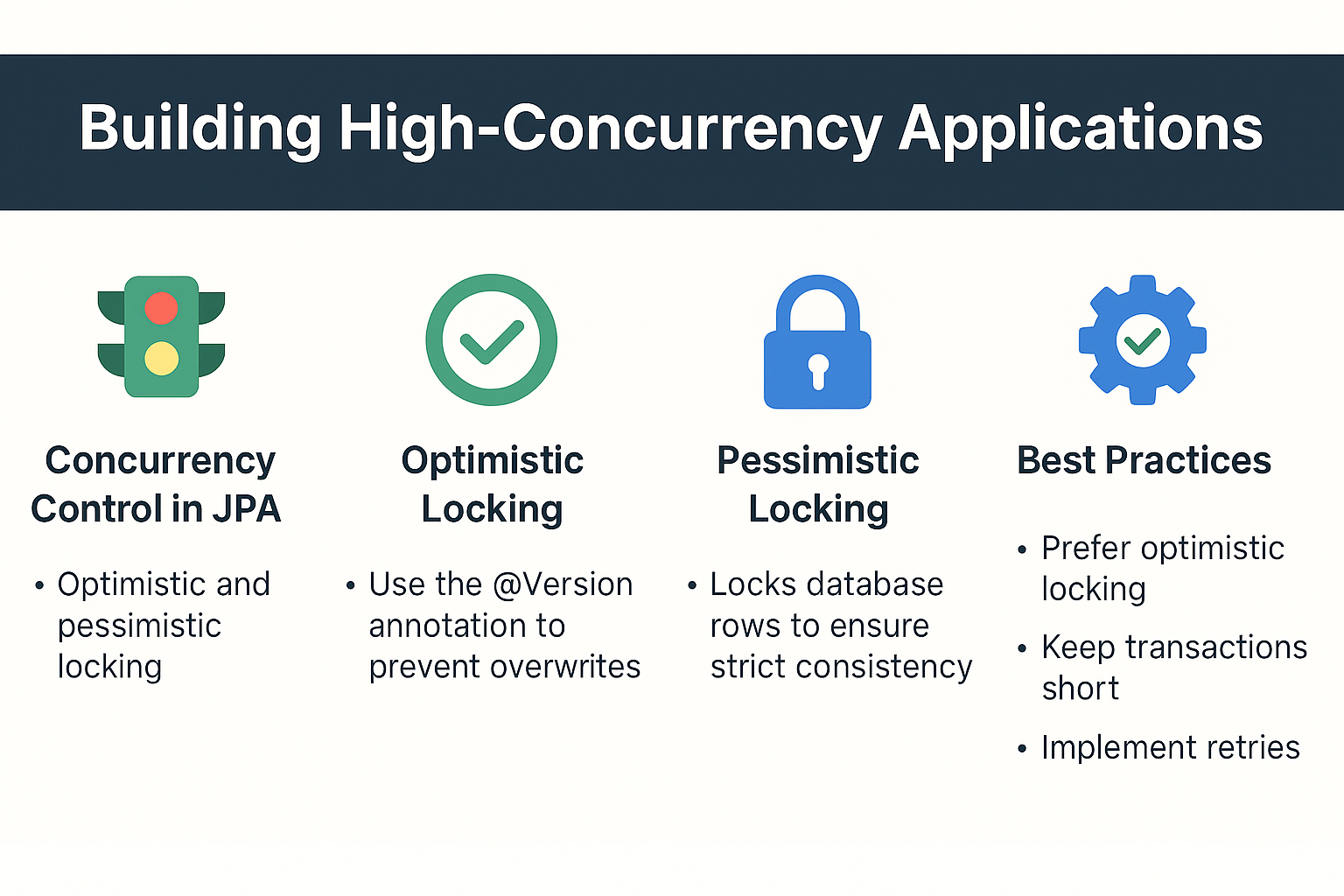In modern enterprise systems, multiple users often access and modify the same data simultaneously. Without proper handling, this can lead to data inconsistencies, lost updates, or deadlocks.
JPA (Jakarta Persistence API) provides powerful mechanisms to handle concurrency control, making it suitable for high-concurrency applications such as banking, e-commerce, and large-scale enterprise systems.
Think of concurrency control in JPA like a traffic light at a busy intersection—without it, chaos ensues.
Concurrency Control in JPA
Concurrency in JPA is primarily handled using optimistic and pessimistic locking.
- Optimistic Locking: Assumes conflicts are rare and checks for conflicts before committing.
- Pessimistic Locking: Prevents conflicts by locking records during a transaction.
Setting Up JPA for Concurrency
persistence.xml Example
<persistence xmlns="https://jakarta.ee/xml/ns/persistence" version="3.0">
<persistence-unit name="concurrencyPU">
<provider>org.hibernate.jpa.HibernatePersistenceProvider</provider>
<properties>
<property name="jakarta.persistence.lock.timeout" value="3000"/>
<property name="hibernate.show_sql" value="true"/>
<property name="hibernate.format_sql" value="true"/>
</properties>
</persistence-unit>
</persistence>
Optimistic Locking with @Version
Optimistic locking prevents overwriting changes by checking a version field.
import jakarta.persistence.*;
@Entity
public class Account {
@Id
@GeneratedValue(strategy = GenerationType.IDENTITY)
private Long id;
private double balance;
@Version
private int version;
// getters and setters
}
Example Usage
@Transactional
public void updateBalance(Long accountId, double amount) {
Account account = em.find(Account.class, accountId);
account.setBalance(account.getBalance() + amount);
// JPA checks version before commit
}
If two transactions update the same account, one will fail with an OptimisticLockException.
Pessimistic Locking
Pessimistic locking locks rows immediately to prevent conflicts.
Account account = em.find(Account.class, accountId, LockModeType.PESSIMISTIC_WRITE);
account.setBalance(account.getBalance() + 500);
Available Lock Modes
PESSIMISTIC_READ— Prevents updates but allows concurrent reads.PESSIMISTIC_WRITE— Prevents other reads/writes.OPTIMISTIC_FORCE_INCREMENT— Forces version increment.
CRUD with Concurrency
@Stateless
public class AccountService {
@PersistenceContext
private EntityManager em;
public void deposit(Long id, double amount) {
Account account = em.find(Account.class, id, LockModeType.OPTIMISTIC);
account.setBalance(account.getBalance() + amount);
}
public void withdraw(Long id, double amount) {
Account account = em.find(Account.class, id, LockModeType.PESSIMISTIC_WRITE);
account.setBalance(account.getBalance() - amount);
}
}
Querying with Locking
List<Account> accounts = em.createQuery("SELECT a FROM Account a WHERE a.balance > :min", Account.class)
.setParameter("min", 1000)
.setLockMode(LockModeType.PESSIMISTIC_READ)
.getResultList();
Persistence Context in High-Concurrency Environments
- Keep persistence contexts short-lived to avoid contention.
- Use extended persistence context only for long conversations (e.g., wizard-style UIs).
- Clear (
em.clear()) or detach (em.detach(entity)) when processing large batches.
Real-World Use Cases
- Banking Systems: Ensure no two users withdraw the same money simultaneously.
- E-Commerce Carts: Prevent overselling products during flash sales.
- Ticket Booking: Guarantee only one user gets a seat.
Common Pitfalls
- Ignoring versioning → Leads to lost updates.
- Using pessimistic locks unnecessarily → Reduces scalability.
- Long transactions → Increase risk of deadlocks.
- Not handling LockTimeoutException → Causes application crashes.
Best Practices
- Prefer optimistic locking for high-read, low-write systems.
- Use pessimistic locks only when strict consistency is required.
- Monitor deadlocks at the database level.
- Keep transactions short and focused.
- Implement retry logic for failed optimistic transactions.
📌 JPA Version Notes
-
JPA 2.0
- Introduced criteria API and standardized locking APIs.
-
JPA 2.1
- Enhanced support for stored procedures and entity graphs.
-
Jakarta Persistence (EE 9/10/11)
- Namespace migration to
jakarta.persistence. - Improved transaction and lock timeout properties.
- Namespace migration to
Conclusion & Key Takeaways
- Concurrency control in JPA ensures data consistency under load.
- Use optimistic locking for scalability, pessimistic locking for strict integrity.
- Keep transactions short, manage persistence contexts wisely, and handle lock exceptions gracefully.
- High-concurrency apps need a balance between performance and data safety.
FAQ
Q1: What’s the difference between JPA and Hibernate?
A: JPA is a specification, Hibernate is an implementation.
Q2: How does JPA handle the persistence context?
A: Like a classroom register, it keeps track of managed entities.
Q3: What are the drawbacks of eager fetching in JPA?
A: Loads unnecessary data, harming performance.
Q4: How can I solve the N+1 select problem with JPA?
A: Use JOIN FETCH or entity graphs.
Q5: Can I use JPA without Hibernate?
A: Yes, alternatives include EclipseLink and OpenJPA.
Q6: What’s the best strategy for inheritance mapping in JPA?
A: SINGLE_TABLE for speed, JOINED for normalization.
Q7: How does JPA handle composite keys?
A: With @EmbeddedId or @IdClass.
Q8: What changes with Jakarta Persistence?
A: Package namespace shift from javax.persistence to jakarta.persistence.
Q9: Is JPA suitable for microservices?
A: Yes, but ensure lightweight entities and schema-per-service patterns.
Q10: When should I avoid using JPA?
A: Avoid for batch analytics or highly specialized database operations.
